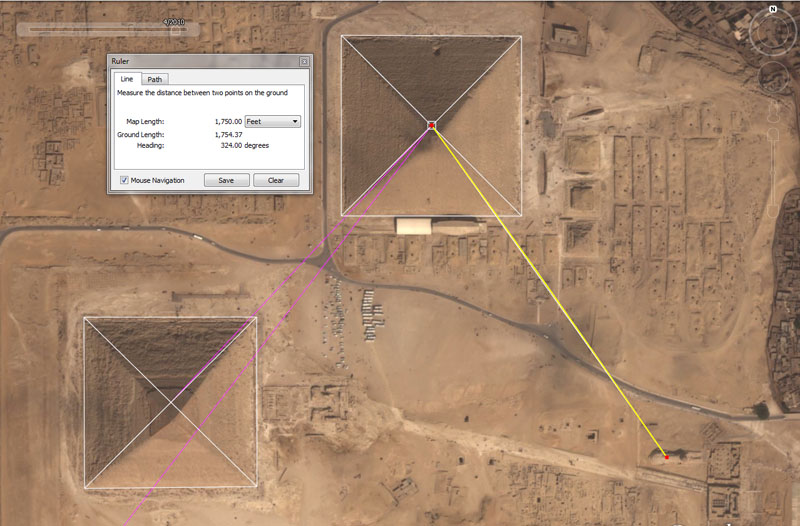
SO, WHAT WERE THE CODES OF POSITION FOR THE PYRAMIDS?
To establish the epicentre position of the Great Pyramid, the 1584' station on the Sphinx was used, at the extreme northern point of the baseline. From that specially carved-out alcove position (see indentation in the foregoing picture), a line was extended at an azimuth angle of 324-degrees and 1750' (or 1/3rd of a Greek mile of 5250') to mark the centre of the pyramid. The return angle back to the Sphinx benchmark was 144-degrees.

A line runs for 1750' @ 324-degrees from the notch or alcove at the haunch of the Sphinx to the centre-position of the Great Pyramid.
Because the line resolves to the centre of a large altar floor atop the pyramid, provision could be made for yet another very important navigational increment. Whereas the (horizontal-line) distance of 1750' represents 1/3rd of 5250' (known nowadays as the Greek mile and based upon the number families "6&7" combined), a distance of 1760' would be 1/3rd of the 5280' mile (based upon progressions of the "11" family of numbers).
In all recorded history, the Great Pyramid has never been observed to have a capstone on top, but only a flat floor altar at a height of 453.6' (equating to exactly 264 Egyptian Royal cubits of 20.61818182")*. The base length of the pyramid complied to 440 of these cubits or exactly 756' of length.
Although there was no literal capstone, one was mathematically inferred by the spot above the pyramid where lines running up the faces would intersect. This aspect preserved the PHI (1 : 1.6180339) & PI (1: 3.1416) ratio codes stringently in-built into the pyramid's dimensions. However, it was far more important to create a top-floor, surveying platform for ongoing use in setting out additional pyramid complexes, to the South especially.
This altar afforded a reasonably large area from which sightings and calculations could be undertaken and, as we proceed, it will become evident that these endeavours atop the Great Pyramid constituted what was, quite probably, the foremost function of the pyramid to the mundane needs of everyday life... that of educating society and maintaining the concept of abundant civilisation.
The angle value, 324, was very important in a mathematical progression that provided numbers related to the duration of the Precession of the Equinoxes (anciently configured to be 72-years X 360-degrees) or 25920-years. Of this time span, the sum of 324-years represented 1/80th part or 4.5-degrees of passage through one of the twelve Houses of the Zodiac.
The ancient mathematicians wished to either literally incorporate or mimic both PI and PHI in the dimensions of structures, or within the duration of astronomical cycles, so created "rounded" increments based upon these two ratios. For this reason half a Greek Stadia was 315' or a "rounded" expression of PI (X 100). But there was also a "rounded form" of PHI (X 100), represented (in whole numbers) as 162 (2 X 162 = 324).
The value, 324 was used in lunisolar, Sabbatical Calendar calculations as well, and the 6804-day lunar nutation cycle is 21 periods of 324-days. This was a multi-use number that cropped up constantly in navigational or cyclic astronomical mathematical progressions.
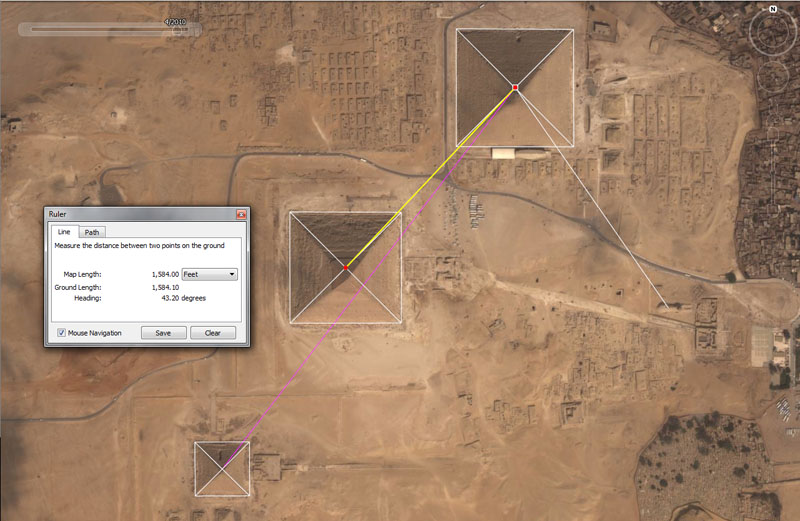
Just as the 1584' distance was used as the surveyor's baseline from the Gebel Gibli pillar to the Sphinx alcove, it recurs here in the distance from the centre floor atop the Great Pyramid to the apex of Khafre Pyramid. at an angle is 43.2-degrees return.
The sum of 1584' is, of course, 3/10ths of a mile of 5280' and a sum of 15840' would equate to 3 English miles or 2 & 3/10ths of an ancient Scottish mile of 5940'. The sum of 1584' would also equate to 288 old English Merchant Navy fathoms of 5.5' or 96 rods/perches of 16.5'. It would also be 24 chains of 66' or 2.4 furlongs/furrowlongs of 660'. The sum of 1584000' would be 96 ancient English leagues of 16500' (3.125 English miles)*
*Note: The ratio of 1 : 3.125 is another rounded form of PI in ancient usage and the old English League mimics PI in its relationship to the mile.
The angle running from the Khafre Pyramid's apex to the centre of the Great Pyramid (43.2-degrees) carries a very important value, much used in mathematical progressions and all manner of calculations. For example, the Great Pyramid's total base perimeter (756' per side) is 3024' or 7 X 432'. Alternatively, one side length of the Great Pyramid can be measured as 432 Hebrew/Celtic Royal Cubits of 21".
Also, the 25920-year duration of the Precession of the Equinoxes is 432 periods of 60 years. Likewise, the 6804-day lunar nutation cycle is 432 periods of 15.75-days (reminiscent of the 157.5' value for 1/4th of a Greek Stadia of 630'). Also, the sum of the 7.2 lunar-years (2551.5-days) monitored alongside 7-solar years in the lunisolar Sabbatical Calendar system equates to 43.2 periods of 2 lunar months each or 86.4 lunar months.
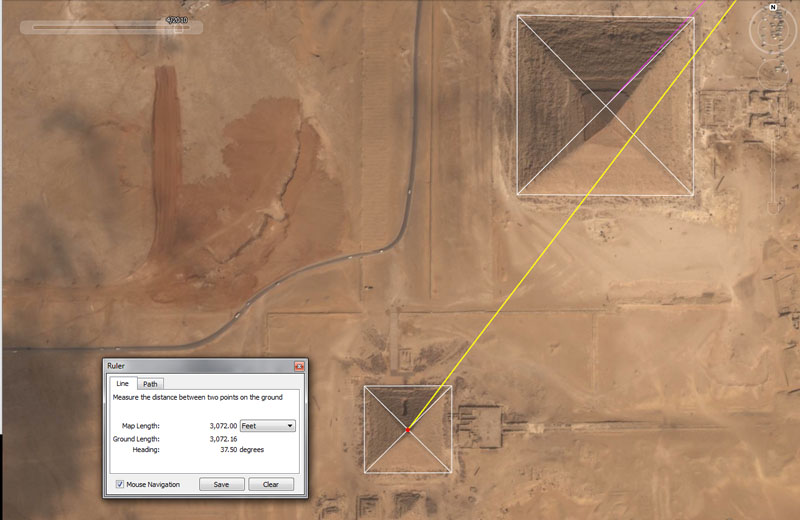
The distance from the centre of the Great Pyramid's top altar floor to the apex of the Menkaure Pyramid is 3072' @ a return angle of 37.8-degrees*.
The simplified ancient method for determining the equatorial circumference of the Earth, for successful navigation, was to say: 12 X 12 X 12 X 12 X 1.2-miles = 24883.2-miles. This is the literal method built into the dimensions of the Great Pyramid's base perimeter, wherein two circumnavigations (@ 756' per side) = 6048' for 1-minute of Earth equatorial arc.
In other words: 6048' X 60 = 1-degree of arc (362880') ... X 360 = 130636800' = 24883.2 Greek miles (5250') for the circumference of the Earth.
Another way of arriving at the 24883.2-mile value was to say: 307.2-miles X 9 X 9 = 24883.2 (or 3072-miles X 81).
In a rather involved mathematical method, the 3072 value could possibly have been used to track the progress of the Moon around the 24883.2-mile perimeter of the Earth. Therefore, 1-degree of arc = 362880' or 118.125 X 3072. It's significant that 4 lunar months is 118.125-days.
The return angle of 37.8-degrees running from the apex of Menkaure Pyramid to the centre altar floor of the Great Pyramid is dynamic navigational coding and half the base length of the Great Pyramid is 378' or 1/16th of 1-minute of equatorial arc.
The Great Pyramid, symbolically at least, incorporated a second navigational system into its base perimeter. Although the length of the Great Pyramid is literally 756', if this length was increased by a mere 3" the entire "English mile" system of navigation would be encoded. Therefore, two circumnavigations of the pyramid would equate to 6050' for 1-minute of arc.
In other words: 6050' X 60 = 1-degree of arc ( 363000') ... X 360 = 130680000' = 24750 English miles of 5280'. By this reading the diameter of the Earth was 7920-miles, whereas the circumference was 7920 leagues of 16500' each.
The 1584' surveyor's baseline running from the Gebel Gibli Hill to the Sphinx alcove (or alternatively the 1584' distance between the Great Pyramid and Khafre Pyramid) are expressions of this 7920 value and 1584' = 792' X 2.
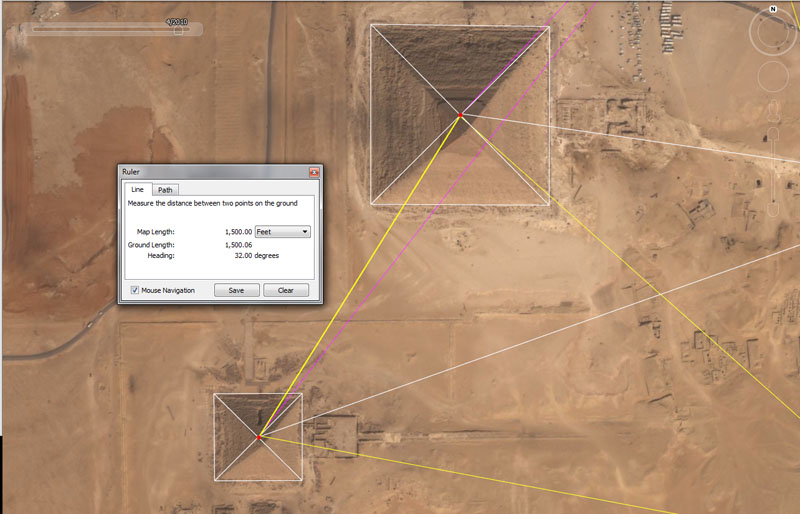
The distance from the apex of the Menkaure Pyramid* back to the centre of the Khafre Pyramid was 1500'* @ 32-degrees.
In the 24750 English mile circumference of the Earth reading, 1/1500th part was 16.5 miles or 5.28 leagues. A league was, of course, 16500' and a mile 5280'.
The 32-degree angle is consistent with the copious use of progressions of the number "8" in ancient calculations. The 360-degree compass was generally read in 320 segments when navigating and this quartering of the compass into primary and secondary points has remained the norm into modern times.
Just as the pyramids are situated at coded distances and angle on the plateau, so were the old temple complexes on the plateau. Everything contained tutorials by way of their dimensions or component positions, number of pillars, etc., and the edifices were very carefully built accordingly.
After the decline of this predynastic civilisation, the codes and true purpose of the plateau "Bureau of Standards" were largely forgotten and subsequent occupiers later turned this amazing mathematical construct into a necropolis for their illustrious dead.
The very ruined, mud-brick pyramids that followed millenniums after probably had vestiges of the old-time coding in their dimensions, but, for the moment we'll concentrate on the oldest stone pyramid structures within view of the Giza Plateau.
*Note 1: The Menkaure Pyramid has been difficult to analyse, as there seem to be widely divergent measurements of its base, ranging as high as 357'.6' ( Dr. I. E. S. Edwards) to 346' (William Flinders Petrie). Using Google Earth imagery, one can see that Petrie was far closer to the mark. One correspondent writes:
Edwards actually gives 356ft 6 inches which is less than the 109 m quoted above but only a little. Many of the errors that have crept into these measurements is through people constantly converting them into other units. I prefer to quote Petrie and Edwards in the units they actually used which is feet and inches even if that's a bit out of date. John Legon has suggested that the Edwards figure is a misprint for 346ft 6inches which is Petrie's measurement. Edward's generally follows Petrie for his measurements but tends to round them off.
Petrie's measurement makes perfect sense as 345.6', which was a much used ancient value that related to the equatorial circumference of the Earth. The Sarsen Circle at Stonehenge had an outer rim circumference of 345.6'. The sum of 345.6-miles would equate to 1/72nd of the 24883.2-mile equatorial circumference.
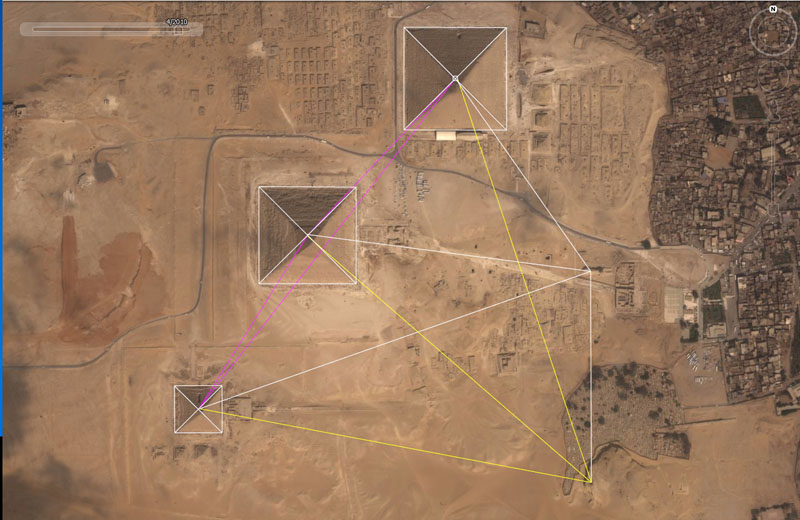
Although the placement of the Great Pyramid went on to determine the positions of both the Khafre and Menkaure pyramids, the position of the Great Pyramid was determined by a coded line running from the alcove section on the back of the Sphinx. The position of the alcove feature in the Sphinx was, in turn, determined by the peak position of the natural stone pillar formation on Gebel Gibli Hill, sitting due South of the Sphinx alcove.
Lines running from either the Sphinx or the hilltop pillar to the Khafre and Menkaure pyramids also carried codes of distance and angle with good relative accuracy, sufficient for tutorials to initiate students who were learning the arts of surveying, navigation and cyclic astronomy.
These distances were:
1. The Sphinx to Khafre's centre apex (based upon a level line reading) = 2126.25' @ 97.2-degrees.
The 2126.25' number is a part of a very dynamic lunar, cycle mathematical progression that provides the values for reading the Sabbatical Calendar. For example, the 6804-day lunar nutation cycle is 32 periods of 212.625-days (212 & 5/8ths).
The angle of 97.2-degrees promotes a value much used in a mathematical progression related to the 24883.2-mile equatorial circumference and 97.2-miles would be 1/256th of the circumference. This is consistent with dividing the compass up into 32 & 64 divisions and yet even greater sub-divisions on that.
2. The Sphinx to Menkaure Pyramid could be read as 3072' @ 70.875-degrees return.
The original design length of the Khafre Pyramid was 708.75' and this is a strong lunar code that occurs on megalithic sites across several continents. The lunar year is 354.375-days or 708.75 ÷ 2.
3. The distance from the Gebel Gibli Hill pillar to the Great Pyramid's altar floor could be read variously across the expanse of the floor, but the main code to the centre would be 3168' @ 161-degrees return.
This distance is navigational and relates to the 24750 English mile reading of the Earth's equatorial circumference.
4. The distance from the Gebel Gibli Hill pillar to the centre of the Khafre Pyramid would be read as 2800' @ 311.04-degrees.
The length is part of a mathematical progression that provided numbers for monitoring the Sabbatical Calendar, as well as readings for navigation under the 24883.2-mile equatorial circumference of the Earth.
The sum of 3110.4-miles would equate to 1/8th of the 24883.2-mile circumference or 45-degrees of arc.
5. The distance from the Gebel Gibli pillar to the centre of Menkaure Pyramid is coded to represent 2953.125' (2953 & 1/8th) @ 101.25-degrees return.
Both the distance and angle are strong lunar codes and 1-lunar month is 29.53125-days (29 & 17/32nds) to a tolerance of under 1-minute. Alternatively, there would be 35 intervals of 10.125-days in a lunar year of 354.375-days.
*Note 2: This distance between the Khafre and Menkaure pyramids would also have also been symbolically represented as 1512' when teaching initiate students of the astronomical and navigational arts, or 1/4th of 1-minute of equatorial arc. Two sides of the Great Pyramid = 1512'.